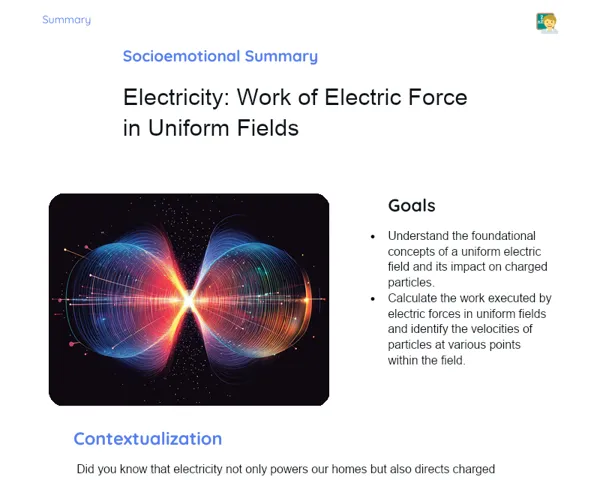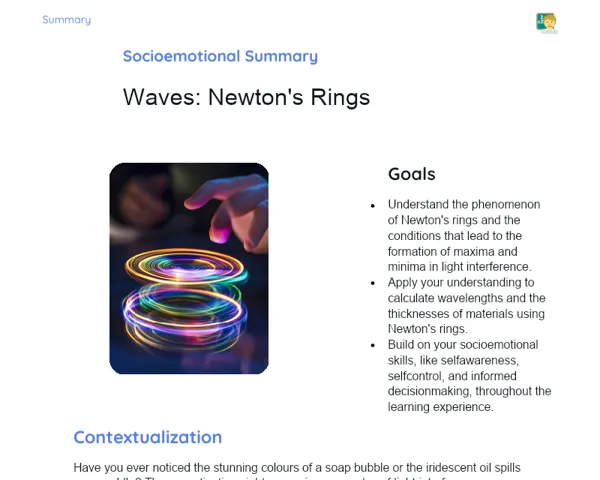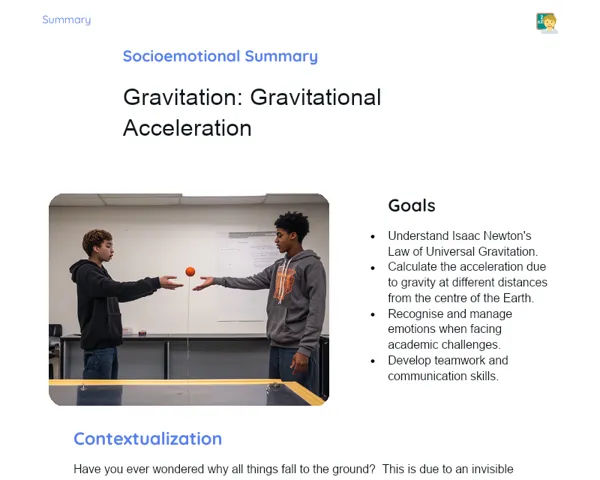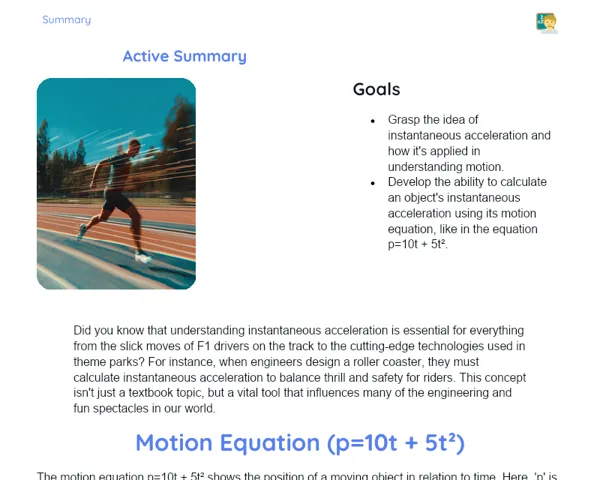Summary Tradisional | Electricity: Generators and Receivers
Contextualization
Electricity is a fundamental aspect of our modern lifestyle, playing a vital role in the functioning of various electronic devices and appliances that we rely on every day, such as smartphones, computers, fridges, and lightbulbs. To power these devices, we need a system that generates and delivers electricity. That's where electric generators and receivers come into the picture, essential parts of any electrical circuit.
Electric generators are machines that transform different forms of energy, like mechanical or chemical energy, into electrical energy. They supply the power required for devices to work. On the flip side, electric receivers are devices that utilise this energy to do work, including motors, lightbulbs, and resistors. Gaining insight into how these components function and interact within an electrical circuit is crucial for troubleshooting practical issues and enhancing the efficiency of our electrical systems.
To Remember!
Electric Generators
Electric generators are machines that convert various forms of energy, like mechanical or chemical energy, into electrical energy. These generators are essential for the electricity we use daily. A common example is a car battery, which turns chemical energy into electrical energy to start the engine and power the vehicle's electrical systems.
There are different types of electric generators, with the most prevalent being direct current (DC) generators and alternating current (AC) generators. DC generators are often used in devices that need a constant voltage, like portable electronic gadgets. In contrast, AC generators are widely employed in electricity distribution because they can transport energy over long distances efficiently.
The functioning of an electric generator is based on Faraday's Law of Electromagnetic Induction, which indicates that an electric current is generated in a conductor when it experiences a change in magnetic field. For example, in a mechanical energy generator, a turbine moves a magnet close to coils, generating electricity.
-
Conversion of mechanical or chemical energy into electrical energy.
-
Types of generators: direct current (DC) and alternating current (AC).
-
Based on Faraday's Law of Electromagnetic Induction.
Electric Receivers
Electric receivers are devices that use electrical energy to perform work, transforming it into other forms of energy such as heat, light, or mechanical energy. Common examples of electric receivers include lightbulbs, motors, and resistors. These components are critical in any electrical circuit since they harness the energy provided by generators to execute specific tasks.
For instance, electric motors turn electrical energy into mechanical energy and are found in household appliances, power tools, and electric vehicles. Lightbulbs, on the other hand, convert electrical energy into light and heat energy, illuminating our homes and outdoor spaces.
The efficiency of an electric receiver is crucial, as it indicates how much electrical energy is transformed into useful work. This efficiency can vary widely between different types of receivers and is affected by factors including the design of the device and the quality of materials used in its construction.
-
Conversion of electrical energy into other forms of energy.
-
Examples: lightbulbs, motors, and resistors.
-
Efficiency of electric receivers in energy conversion.
Electric Circuits
An electric circuit is a network of interconnected components that allows electric current to flow. The basic elements of an electric circuit comprise a power source (generator), conductors (wires), and receivers (devices that use energy). The aim of a circuit is to create a pathway for the electric current to move through and perform work within the connected receivers.
Circuits can be divided into different types, such as series circuits, parallel circuits, and mixed circuits. In a series circuit, components are linked one after the other, so the current passes through each component in sequence. In a parallel circuit, components branch off separately, allowing the current to split and flow through multiple routes at the same time.
In addition to the basic components, an electric circuit may incorporate control devices such as switches and fuses, which help manage current flow and protect components from overload. Circuit diagrams are often used to visually depict the layout of components and their connections, making analysis and problem-solving easier.
-
Combination of generators, conductors, and receivers.
-
Types of circuits: series, parallel, and mixed.
-
Control devices, such as switches and fuses.
Real Generator
A real generator differs from an ideal generator because it has internal resistance. This internal resistance is a natural property of the materials and components used in building the generator. Due to this internal resistance, some of the energy produced is lost as heat within the generator, resulting in a potential difference (voltage) that is lower than the electromotive force (emf) initially delivered.
The relationship between the emf, internal resistance, and current in a real generator can be expressed with the formula V = E - r * i, where V is the potential difference at the generator's terminals, E is the electromotive force, r is the internal resistance, and i is the current. This formula is vital for understanding how internal resistance impacts the performance of the generator and the energy available to the receivers in the circuit.
When designing electrical circuits, it is essential to factor in the internal resistance of generators to ensure that the devices connected receive the right amount of energy. Moreover, the efficiency of a real generator can be enhanced by reducing its internal resistance, allowing more of the emf to be converted into useful energy.
-
Has internal resistance that causes energy dissipation.
-
Formula: V = E - r * i.
-
Importance of considering internal resistance in circuit design.
Key Terms
-
Electricity: The form of energy produced by the movement of electric charges.
-
Electric Generators: Devices that convert various forms of energy into electrical energy.
-
Electric Receivers: Devices that consume electrical energy to perform work.
-
Electric Circuits: A set of interlinked components that allow for the flow of electric current.
-
Real Generator: A generator with internal resistance affecting the supplied potential difference.
-
Potential Difference: The difference in electrical energy between two points in a circuit.
-
Electromotive Force: The energy provided by a generator to move electric charges.
-
Internal Resistance: The resistance within a generator that causes energy to be lost.
-
Faraday's Law of Electromagnetic Induction: A principle explaining how electric current is generated in a conductor as a result of a changing magnetic field.
-
Ohm's Law: The relationship between voltage, current, and resistance in an electric circuit: V = i * R.
Important Conclusions
Electric generators and receivers are key components that allow electrical circuits to function, converting various forms of energy into electrical energy and vice versa. Comprehending these devices is necessary for addressing practical issues and improving electrical system performance. By understanding the distinction between ideal and real generators, learners can conceive more efficient circuits—taking into account the internal resistance of generators and how energy is distributed to receivers.
The significance of grasping electrical circuits, whether in series, parallel, or mixed formats, was emphasised, enabling students to identify and analyse the arrangement of components and their interconnections. Additionally, applying theoretical concepts to practical examples, such as calculating current and potential difference, bolstered the real-world relevance of the learned material.
The lesson also included Faraday's Law of Electromagnetic Induction and Ohm's Law, essential principles for grasping the workings of electric generators and receivers. These concepts are crucial for fostering innovative technological solutions and maintaining efficient, safe electrical systems. We encourage students to dive deeper into the subject and apply this knowledge in real-life scenarios.
Study Tips
-
Review the fundamental concepts of electricity, such as potential difference, electric current, and resistance, to reinforce your theoretical foundation.
-
Practice solving problems involving electric generators and receivers, using various circuits to solidify your understanding.
-
Explore Faraday's Law of Electromagnetic Induction and Ohm's Law in greater detail, applying these principles in practical contexts and everyday examples.



